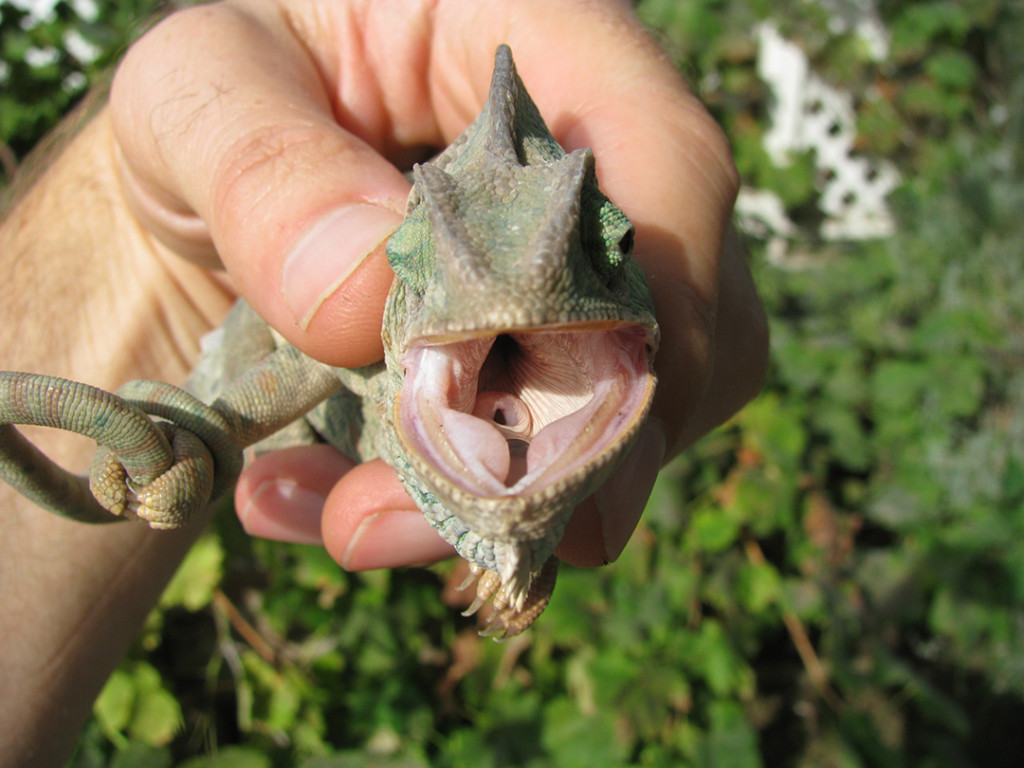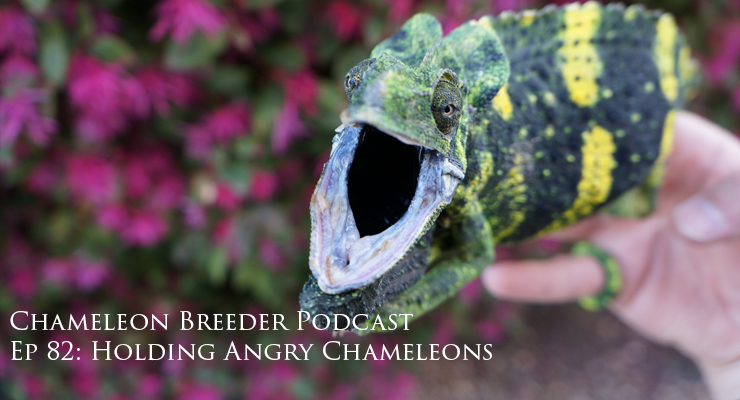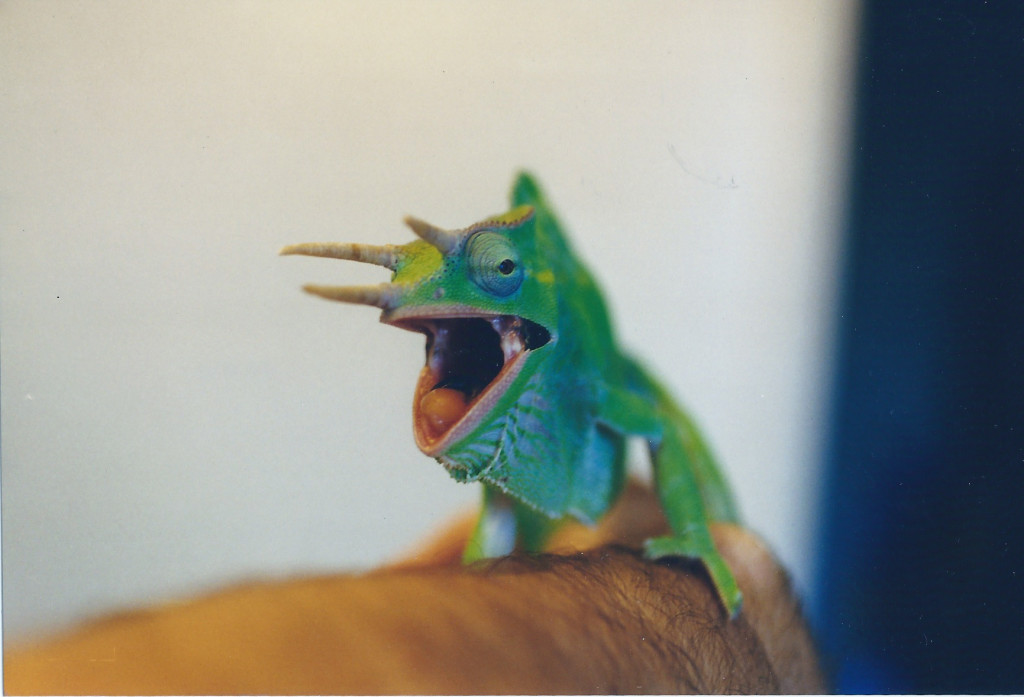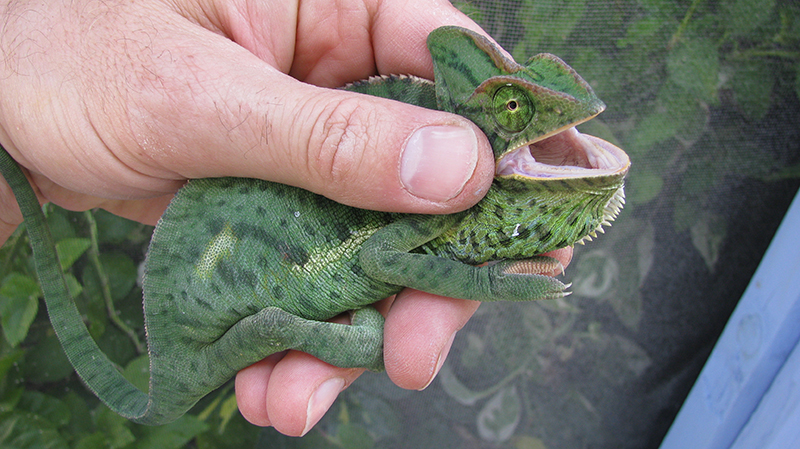Ep 82: Holding Angry Chameleons
How to hold a chameleon that is going to want to bite you.
Good morning Chameleon wranglers! Today we are going to talk about a special handling case and that is when the chameleon is scared – or angry- enough to bite you. The only time you should ever handle a chameleon who is scared enough to want to bite you is if it is required for medicating them for their health. There may come a time when you will have to deal with a chameleon who has gone way beyond annoyance with your antics. Should that time come, you’ll need to know how to handle this fiery tree dragon.
See the companion video! A huge thanks to Luis Wiedemann and Nicole Paddock for helping demonstrate holding a chameleon that needs medication attention.
[youtube]https://youtu.be/fEmRmGZ7tpw[/youtube]
So you are now having to carry out your veterinarian’s medication instructions. Your patient is a chameleon that wants nothing to do with your and your accomplice’s nefarious plans. Many chameleons will shy away from your hand and be nervous. We want to respect these creatures and their fear. No one ever tamed down through force. But you do not have the time for months of taming sessions because you need to deparitisize your chameleon. If you don’t need to medicate your chameleon or perform an exam for medical reasons then there really is not a good reason for holding a chameleon that is trying to bite you. I suppose one exception is when you are trying taming sessions, but then only if you are getting the chameleon on your hand to show to your chameleon that he won’t be hurt by your hand. But if your chameleon insists on biting you will have to be the type that can take a bite calmly to let your chameleon get all that aggression out and you showing him that you are not phased by his worst. Even when he is giving you his worst you will not hurt him. We will go into taming later. Today is all about dealing with the handling of a chameleon that is in a biting mood.
There are a number of medical procedures you may be called upon to perform at home. These include giving oral medication, wiping ointment on skin, and injecting fluids subcutaneously. Sub is “under” and “cutis” is skin so these would be injections under the surface of the skin. All of these will involve a chameleon that very well may be – will probably be – resisting. Now, before we get into this I want to set the limits of what we will go over in this episode. I am going to go over the handling techniques and strategies that are necessary to safely deal with a chameleon that is actively protesting. We want this done quick, effectively, and with no damage to the chameleon. Every second you are restraining him is taking you backwards as far as your relationship. Medication is necessary, yes, but the process is not without cost. Chameleons remember and they are not quick to forgive traumatic events. I am not going into detail on how to administer medication. That is definitely something you need to be shown by your vet. I have done all sorts of administrations, injections, and other procedures, but I am not a vet and if you are doing those things it will be under the supervision of a vet with medicine you got from the office. I know it is easy to work around this, get your advice from the internet and the medicine from across some border or from a friend. This is not a reliable method to follow. These procedures are not necessarily hard to perform, but doing it wrong can kill your chameleon. Rely on your vet for hands-on instruction, but on this podcast I can certainly deal with the handling aspect!
When faced with your hand or branch, your chameleon’s reaction will be some mixture of fear, indifference, and aggression. This will change depending on size, age, acclimation, and species. So let’s just take it to the limit and go directly to the far extreme. Let’s talk about those firebrands that just want you dead. They have no trouble showing you their intention to bite and it is not a bluff. Chameleons can and do bite. They have true teeth and have beetle crushing jaw strength. You will not lose a finger to an irate chameleon bite, but it can certainly break skin. I have had a number of bloody marks in the shape of a chameleon jaw in my lifetime. The surprise of it is usually more shocking than the pain of it, but there can be some blood. Lucky for us chameleon keepers, when chameleons are planning to bite us they give us advanced warning. They puff up the body, flash their brightest colors, and can even give warning lunges that have an unmistakable message of intent. A chameleon bite is rarely given without ample warning. So if you learn their language and are respectful of it you should be able to live your life without a chameleon bite.
But, say we have to medicate this rage beast. How do we do this? If you are lucky, the rage beast will puff up and gape at you and you will be able to squirt his medication in his mouth without even having to pick him up. Once the chameleon figures out what you are up to this option may close, though. Chameleons learn quick and I was able to pull it off on one chameleon a couple of times and then my trick was over with. She learned not to open her mouth around me. So I got all the aggression and sass, but with no open mouth. If you are faced with a chameleon that needs to be medicated and it is not having it then we are going to have to literally hold our chameleon which is what I previously said to avoid if at all possible. But it is now required – so here we go.
To hold a chameleon that wants you dead you are going to have to hold it behind the head. But this is NOT a pinch. You are not squeezing your chameleon. You are providing a firm structure that allows your chameleon space to breath normally and unrestricted, but prevents the head from being able to come around and bite you. Now, some of you who have gone through this before are raising your hand to point out that there is a step that I just glossed over. We have to get the chameleon into your grip to begin with… And this is not straight forward… Your chameleon is already wise to what you are up to and instinctually protects his backside. Having the ability to see in two directions at once doesn’t make things easy for you. You will have to capture him. I would like to remind you, once again, that if your chameleon is fighting like this then this is not the time for having a bonding session. I am offering this method to be used only when it is necessary to give them medication and the stress spike of being captured for that moment is less harmful than the constant stress exerted by, say, a parasite load or a deadly infection.
You’ll have to use two hands. Position one hand behind him and then one hand in front of him. He will react to the one behind and then to the one in front. When he goes for the one in front, your hand behind has to move quickly to encircle the body with thumb and forefinger behind the skull. What follows is either a flopping around where the feet and tail will release and you have a madly squirming chameleon or else the chameleon will double down on his grip on his branch with feet and that muscular tail. If he doubles down then you will have to use your other hand to VERY GENTLY pry his forefeet off the branch and replace them with a finger so he has something to hold on to. You then move to the back feet and do the same thing. Lastly the tail. Start with the tip and slowly unwind. This is in no way easy and you may have to begin again if any of his appendages slip out and grab the branch again. This is the longest part of the process and one you cannot rush.
Easy or hard, once you get his grip off the branch and are pulling him out of the cage be very aware of where that tail and feet are. Your chameleon’s instinct is to reach out and grab anything that might save him. This means that in the middle of you pulling him out of the cage his tail may wrap around something else and you could easily break it if you keep pulling him out without realizing his tail grabbed something on the way out. When you have five appendages, including a long tail wildly slithering everywhere, it is hard to keep track of it all. The slower you go the more likely they’ll find something to grab onto. Move quick and you could easily break the tail bones. You’ll have to find an acceptable middle ground that depends solely on your unique situation.
Medicate quickly and then gently release your chameleon in a safe place. Most of the time your chameleon will be more than happy to use his cage branch as a get away. Just release them onto the branch and life is good. There are more dramatic sorts where this may be difficult. One chameleon defense is to drop to the forest floor. Your chameleon may want to drop to the ground when you release them so when you put them back, if they seem the dropping sort, I suggest letting him go on the floor of the cage or in a potted plant where he will not damage himself if he refuses to hold onto anything. His only thought may be to bite you and drop to the forest floor. He does not have his own safety in mind because in his chameleon brain he is already as good as dead. How you put a chameleon back is as important as how you pick him up. Before you get too concerned I want to reiterate that I am talking about an extreme case here. Most chameleons will quickly scamper off your hand onto their branches and life is good. A standard captive bred panther chameleon will consider your handling as an insult to their dignity and give you the stink eye before they calmly crawl into their plant. So this is dealing with that chameleon that just hates you. People that deal with wild caught animals are more likely to run into these animals. I apologize to the ones that have heard this story before, but I love telling it. This is my very foul tempered captive bred female panther who hated me more than any wild caught ever did. She did not bite because she was scared. She bit to punish me for existing. I had her on my hand and she looked at me with distain with that little lip curl they do. Keeping her eye on me she gently tested certain areas on my hand to see where she could get a good grip. I pretty much knew what she was up to (indeed, she earned the name “Bad Girl” long before this) but I watched in fascination because I had never seen a chameleon be so methodical in carrying out an attack. Once she found the perfect spot she latched on with all her ferocity and was tearing so passionately that her back legs came up off my hand and her body was flopping about as she tried to take a chunk out of me. Luckily, this kind of aggression is not common! I survived that attack with only a chameleon mouth shaped ring of blood, but every time I would walk by her cage she would give me that look that was inviting me to a rematch. She was in a six foot tall heavily planted cage so she didn’t have to be right there at the front waiting for me… There are exceptional chameleons out there. Some of them are exceptional in the way they transcend their chameleon nature and do not fear humans. These rare individuals seem friendly and have no problem walking on us and going for walks. Some, like Bad Girl, use their lack of fear for humans to plot the overthrow of humanity and win Earth back for the reptiles. And, me? I was just ground zero.
Now, this is the perfect time to take a break from handling and discuss reactions to biting. Biting is a chameleon’s defense of last resort (unless you are Bad Girl). It is when they are trapped and scared for their lives. You truly have no business being bitten by a chameleon because it means you should have stopped what ever you were doing long before that step. If you are bitten it better be because you are doing something you absolutely have to do for your chameleon’s health and you know the risk. If you at any time take this personally and decide to punish your chameleon for the fight or flight attitude or biting you then you are not fit for chameleon ownership. I really hardly ever talk like that. But it truly applies here. Your chameleon did not ask to be placed in your care. They owe you nothing. You NEVER flick, drop, or fling your chameleon. You are NOT entitled to their everlasting love, affection, and respect. They will literally die before being everything you demand of them. Even our multi-generation bred panther chameleons are just a couple decades out of the wild. Yes, some adjust to being pets quite well – happily ever after – , but they are still wild animals. Yes, we control every aspect of their lives and have made their life decisions for them, but we only own them by the sense of human law. By nature’s law we must come to them as guardians. They are what they are. We can try and acclimate them to our world, but we cannot be arrogant enough to demand they become something different then what they are. They owe us nothing. We owe them the absolute best life we can give them. It is our job to accommodate them, physically AND emotionally, with whatever they need.
Just about all the time, a bite is a quick attack and retreat. Rarely, though, a chameleon will bite and hang on. I have had them bite and then try to work their way deeper. It is quite disconcerting to realize there is some crocodile in the lower recesses of our beloved chameleon’s brain. If you are bitten, consider that a warning that another bite is imminent unless conditions change. And by conditions I mean how close you are to your chameleon. This can be difficult if the chameleon is crawling on your arm and biting at your other hand that is trying to keep said rage beast away from your ear and face that are in the direction the chameleon is running. This is where we start losing control and start feeling that fight or flight coming up in ourselves! Please try and keep yourself in your higher brain functions and realize that your chameleon will not be seeing your ear or face as a place to attack you. Well, probably. I wouldn’t put anything past Bad Girl, but, most likely, this chameleon is just trying to get to the top of your head which is security in their brains. They are not looking for your weak spots. The best way for you to reset the situation and get you both back in your corners is to lean up against curtains or anything else that your chameleon can climb on to get away from you. Once there you can try and move him by getting him on a branch or, if all else fails, just turn off the lights and wait until your little angel falls asleep. Take out your flashlight and find your chameleon. You may need a ladder or step stool. You then use the safety grip with one hand enveloping the body and preventing the head from turning back on you. The other hand will gently pry the feet an d tail off the perch with the job of making sure the thrashing tail does not end up in the aimlessly chomping mouth. Gently place your chameleon back into his cage by placing one foot at a time on the perch until all four are grabbing the branch. You can then let go. Sometimes you chameleon will complicate things by grabbing their own body parts. It is comical, but frustrating when you can’t pry a foot off of a leg without hurting the leg. Often the situation will right itself when the other feet are firmly grasping a branch. But if you do this while they are asleep they may still have their eyes closed and you’ll have to help them regain their footing. Just put the other two feet on the perching branch and support the chameleon only as much as is necessary to keep them from falling. As the adrenaline dissipates the normal brain functions will engage and the chameleon will revert back to normal branch perching. You can then slowly step back and say good night to your friend.
There are cases where your chameleon will bite and not let go. This is a very frightened chameleon or one working solely off instinct. I had a female quadricornis in one of these six foot tall outdoor heavily planted cages. It was a late night and I was doing my night check to make sure no chameleon was sleeping on a wall part of the cage that could be accessible by opossums. Sure enough, she was on the far back screen wall. So I leaned far into the cage and could reach her only by hanging on the front cage frame. I was teetering, but I could just reach her. I got her first two feet off the screen with my fully outstretched hand when she, in her sleep, rounded about and sunk her teeth into the fleshy part between my thumb and index finger. It hurt to high heaven. But here I was teetering on one foot, leaning towards the back of the cage and my entire weight supported by my grip on the cage frame. I could not pull towards me without hurting her back two legs and there was nothing substantial enough to support my weight if I moved forward into the cage. Nobody could hear me to come and help and I sure was not going to start yelling for help. Can you imagine how I would explain to my neighbors what I had gotten myself into? Well, I had time to think as I was this living sculpture frozen in place attached by a sleeping chameleon with her mouth painfully chomped on my hand. And she was grinding in her sleep! What the heck? Every time I shifted weight just a little she would grind deeper! So I was literally frozen in place! My arm was quickly getting tired and I eventually had to ignore the pain of the bite and was able to work her back legs and tail off. If you find yourself in the very rare situation where your chameleon has clamped down on a body part and won’t let go you will have to place you chameleon on a place where he feels secure and believes he has a chance to escape if he lets go. Yes, I am telling you that you have to ignore the pain and rise above the panic of an animal taking a bite out of you. He actually may be maintaining the bite as an anchor point and not solely an aggressive move. Quickly, but smoothly, put your chameleon in his cage with his feet able to solidly grip his perching branch and he probably will release to try and escape. You can try bringing your other hand up and see if a second menacing target distracts him. Gently tap his snout or even grip his nostrils and see if giving him that distraction helps your situation. But in all of this you have to remain calm! You being bitten is never an excuse to harm this chameleon. Yes, you are in pain, but your life is not in danger. On the other hand, your chameleon thinks this may be his last day and his body cannot stand against the strength of your muscles. You have to put your pain aside and think about the safety of your chameleon. This is our duty as their guardian.
Once this ordeal is over and your chameleon is safely back in his cage you can tend to your conflicted feelings. Take care of any skin breaks you may have received and sink back in your recliner with a cold root beer (this is a family show). Catch your breath and contemplate how to avoid this happening with the next dose you must administer!

Whew…let’s get back to the medication part…
Giving injections or wiping ointment can actually be easier than giving oral medication. Injections come with their own sets of risks. Obviously, puncturing something you shouldn’t is high on that list! Injections and applying ointments require only a firm grip to keep the chameleon immobile. If your target area is the flank or the arm pit areas then you will appreciate having a friend help you. It will take two hands. One to hold the body of the chameleon and make sure the biting end stays in a safe direction. The other hand to hold down the legs and/or tail. Depending on how active your chameleon is while in your hand you may need two hands simply to keep the tail from thrashing about. While it is not dangerous to you, the chameleon may be thrashing about trying to bite your finger. If their tail or even foot gets in the mouth they will bite down on it and can easily break and bloody their own tail. I do not like putting something in their mouth to give them something to bite down on. This is a personal preference as I do not want them breaking their dental arcade in a fit of passion. I need to be clear that I have never seen this happen – so somebody may do this and have it be successful. I am just sharing with you why I have decided not to do this. I try to give the most factual information in this podcast as possible, but much of what we all do is just a result of logical thought. I’ll do my best to let you know when what I suggest is a result of that thought process. I want to you know the “why” behind everything. Challenge everything I say, integrate what others say, and make it real for you. “Well, that is what Bill Strand says” is not a good argument for doing anything. My dashing good looks and rapier wit are certainly compelling, but I work hard to give the reason behind what I say so I hope it can make sense. I study the topics, bring on experts, test as much as I can, and work hard to present the information I have in as useful a format as possible. You can take what I say as a man who has had close to 40 years of experience, but is working on his next 40 years of learning. This podcast is merely me sharing where I am and taking you along with where I am going.
Hmmm, I feel I have tangented somewhere along the way! We were talking about chameleons that are not being cool with your agenda. Wearing gloves is one way to deal with the claws and possibly teeth that may be brought to bear upon you. There are some that will advise against gloves. The reason for this is because it is a barrier between you and your chameleon. I really have no idea what a chameleon thinks about a gloved hand and I do not have any background that tells me that it makes a difference. I have rarely used gloves in my many decades, but when I have I noticed no emotional damage or relationship harm. If I am using a glove for protection the relationship is pretty low to begin with. Some people believe it does make a difference. When you are doing taming exercises it does make sense that if they get used to a gloved hand being safe that they may not extend that to an ungloved hand. In the present case, though, we are talking about a necessary application of medication. So if a glove is necessary to get the job done then use the glove. And, it might not hurt your future taming exercises if the hand that did the medication is different than the hand that is trying to be friends. I don’t have a study that says this, but it makes sense to me.
Although I am going to avoid talking about medicine, this is a good place to talk about the internal structure of your chameleon’s mouth. We breathe and eat down the same throat and further into our body cavity there is a valve that makes food go in one direction and air go in the other direction. I don’t know if the correct authorities are listening to this, but I question the wisdom of that design. I feel it pretty much invented 90% of the choking industry. But I understand that this model has been in production for a while now and that a recall would be outrageously expensive so I guess we humans will have to continue to breath and eat with the same tube. Chameleons are a little different in that at the base of their mouth you can see their air intake tube and then this cavernous hole that leads to their digestive system. This is very important when you are squirting medicine into your chameleon’s mouth. If you squirt it too shallow into the back of the mouth area you may shoot it into their air hole and kill them. Way back into the throat is best or by their tongue if you only get their mouth open a little. Their natural swallowing reflex should do the rest of the job. For reference, check the show notes for a picture of an open chameleon mouth to see the location of the air hole. This would be the big “avoid” spot.

Now, how in the world do we get them to open their mouth? As I said earlier, the absolute best situation is when the chameleon is annoyed with you so much that they gape and threaten you with an open mouth. Squirting the medicine in is easy. Just avoid that air hole. If they clamp down on the syringe then get the medicine out and release the syringe. Most of the time, they will let go of it as it is no longer a threat and turn back to face you. If the medication process is over with then mission accomplished and you can let you chameleon go on with its day without ever picking him up.
Chameleons may get wise to this and then you either have to change the way you annoy him or else you must pick him up and induce a mouth opening. But here are some ways to get a mouth open without picking your chameleon up.
- Bring your hand up towards the front of him
- Tap him on the nose (VERY gently!!)
- Bring your hand up from behind. You may get a gaping just by being near by.
- Place your hand over the back of your chameleon as if you are going to pick him up. Just the threat of picking him up may get a spirited response.
- Go ninja on him: feed him and then squirt the medicine in during the chewing. This sounds deliciously tricky and you feel pretty smug pulling it off. The problem is that your chameleon is not stupid and has evolved advanced methods to thwart your smugness. You may not be able to pull this off more than a couple times. Please note the look your chameleon gives you when you do this. That would be pure disgust.
If all these attempts fail you may be left only with physically picking him up. The very act of picking him up may get you your gaping. If your chameleon gets wise to this – and they do – we go a step further. You can move your thumb and one finger forward on either side of their snout to where you are covering the nostrils. If even this will not produce a gape, you can try the previous nostril covering while you gently pull on the gular pouch. This has to be done very gently as it could harm your chameleon. When you take you chameleon into the vet to get that medicine you have ask the vet to show you how to administer the medicine. Definitely ask how you can get your chameleon to open his mouth if you are being prescribed an oral medication. Practice it under the supervision of your vet until you are comfortable doing it on your own.
There are always other bits of advice floating around out there that include using a credit card or other common object to pry the mouth open. I am going to send up a big warning flag. I do not like applying any force to the dental arcade. The dental arcade is the rows of teeth. I have seen too many of these broken and/or detached to feel comfortable using them to pry an object against the strength of the jaw muscles. If a tap of them makes the chameleon open their mouth then success I say. But if there is any prying or using muscle involved please reconsider because this will be a movie that will have the audience squirming in their seat. The dental arcade does not have the strength to hold against our arm muscles. And there isn’t that substantial of a ridge of teeth to apply pressure without the real danger of slipping and sending your prying implement into the gum line. A damaged gum line from a slip is the last thing you need for the rehabilitation and taming of your chameleon.
Any chameleon can find itself in need of taking medicine. But I would like to say that there are a couple of things you can do to avoid having to go through the ordeal of medicating and handling a chameleon that is in the mood for biting. The best thing you can do to avoid this trouble is to buy a captive bred specimen from an established and reputable breeder. You would not believe how much trouble you just instantly bypass when you go captive bred. The second thing you can do is to make sure you have everything you need for your chameleon’s environment to be set up correctly. You can be proud of being Mr. Bargain Hunter, but do not compromise on quality. Get a cage that has enough space. Get the best lights possible. Invest in a misting system. Get those supplements and train yourself on feeder gutloading. Chameleon keeping can be easy and trouble free. All it takes is one problem with a vet visit and medication and possibly losing your chameleon to totally wipe out any savings you may have gotten.
Conclusion.
And that, my friends, is a bit of talk on dealing with a chameleon that deals with medicine taking like I do when I have to get a shot. It is one of the more challenging times in your chameleon ownership. Much of what I talked about today would do well to have pictures to illustrate. So this would be a good episode to check out the show notes at chameleonbreeder.com. There I’ll have illustrations. I also have a video showing one of our community’s senior members, Luis Weidemann, medicating his parsons chameleon. This parsons’s has not read the books about being a gentle giant and Luis gets to deal with a not so friendly face. Does he get bit? Well, Luis is pretty good at this so he is going to show you how it is done. But I keep playing the video over and over because I am convinced that one of these times the Parson’s will get him! The link is in the chameleonbreeder.com show notes.
It was great spending this time with you. Next week I host a chameleon roundtable discussion on the state of Furcifer lateralis, the carpet chameleon, in captivity. If you are interested in a beautiful chameleon and can keep a panther healthy, check out this episode.
Until then, get your UVB, take your calcium, and set a good example for your chameleon by being healthy yourself.














